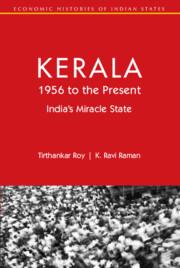Book contents
8 - Geography: An Asset or a Challenge?
Published online by Cambridge University Press: 31 May 2024
Summary
The state's climate is unique among Indian states. Following the Koppen– Geiger classification of climatic regions of the world, over two-thirds of the land in India is tropical savanna, desert or semi-arid. Most of Kerala is monsoonal or highland tropics. The difference is this. The average summer temperature in the former regions can reach levels high enough to dry up surface water. The monsoon rains relieve that aridity, but only for a few months in a year. That dual condition makes water storage and recycling a fundamental precondition for economic growth. It elevates the risk of droughts and diseases from seasonal or periodic acute water shortages. Kerala, by contrast, does not get as fierce a summer as the other areas of India and receives a lot more rainfall. That dual condition implies a natural immunity from seasonal food and water scarcity and a low disease risk.
With its extraordinary biodiversity, this is a vast storehouse for natural resources. The state has a surface area of 38,855 square kilometres and is bounded by the Arabian Sea to the west and the Western Ghats to the east. The eastern highlands, the central midlands and the western lowlands, with 580 kilometres of coastline, can access a wealth of ocean resources and means of subsistence for their fisherfolk and the general populace. Compared with semi-arid India, the benign environment largely explains the head start in life expectancy (Chapters 1 and 6). Further, nature provides industrial resources that cannot be found elsewhere. The highlands have the ideal climate for growing coffee, tea and spices. Low hills are often planted with rubber. The seaboard traded with West Asia for centuries. The state's Gulf connection, thus, had a prehistory. A large tourism business has developed by selling nature.
On the other hand, recent experience shows that climate change and overdevelopment can jointly raise the risk of disasters. In the first three weeks of August 2018, Kerala received 164 per cent of the average rainfall for that time of the year. The following floods were devastating, comparable only to a similar event in 1924. In 2019, extreme weather repeated, now causing landslides. Mining and quarrying, frequent blasting and unscientific changes in land use patterns affected the highland ecology.
- Type
- Chapter
- Information
- Kerala, 1956 to the PresentIndia's Miracle State, pp. 134 - 143Publisher: Cambridge University PressPrint publication year: 2024



